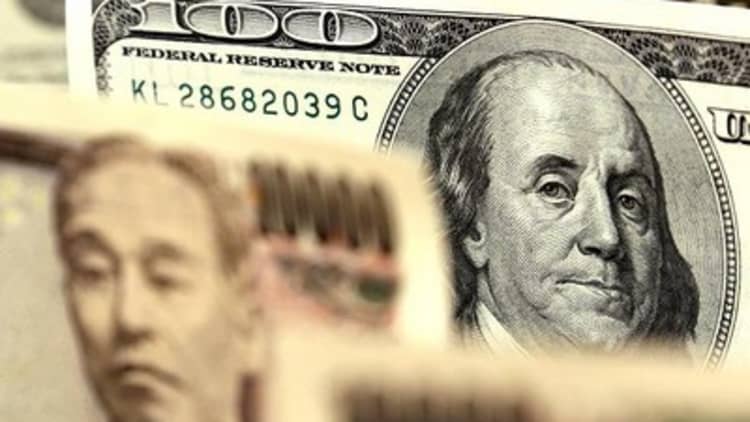
The dollar has been on fire.
It's sitting at a seven-year high against the Japanese yen, a two-year high against the euro, and the broader dollar index is at the highest point since March 2009.
As the dollar marches higher, it's gaining a lot of fans along the way.
Read MoreThe dollar-yen trade is back...and could be better than ever
Hedge funds and other large speculators have been boosting their long dollar positions. It's now a $48 billion bet, the largest since 2008, according to weekly data from the Commodities Futures Trading Commission.
But new highs and crowded positions aren't keeping top strategists from betting on the buck in the new year.
Dollar strength has been fueled by better economic data in the U.S. relative to weaker numbers and trends in Europe, Japan, China and elsewhere. That's created an interest rate gap in the dollar's favor, as the market positions itself for a interest rate hike from the Fed in 2015 and easier policies elsewhere.
Read MoreEuro rallies from two-year low as investors pare back QE bets
Recent reports on the U.S. economy—from services to manufacturing to jobs—confirm its ability to withstand global weakness and outperform other major economies.
That lays the groundwork for continued outperformance, or what Deutsche Bank's Chief Currency Strategist Alan Ruskin calls "U.S. growth exceptionalism."
Just this week, third quarter growth was revised up to 3.9 percent, and that number may be revised higher. After Tuesday's strong report on construction spending, CNBC's rapid GDP tracker shows it may be revised even higher to 4 percent growth.
That follows 4.6 percent growth in the second quarter and would mark the first back-to-back 4 percent quarters since 2003.
That kind of resilience in the face of weaker global figures reaffirms economists' faith in the U.S. in 2015.
"Strong growth, more hawkish Fed," is Renaissance Macro chief economist Neil Dutta's "macro mantra'" for the new year.
Beyond a stronger, outperforming economy, there's another related factor that could propel the dollar to new heights in 2015—a more aggressive Federal Reserve.
Read More
"Last year, we were above consensus on GDP. This year, we're hugging it. The difference lies in our expectations around the Fed: We see earlier and more aggressive rate hikes," Dutta said.
Most economists and strategists predict we'll see the first rate hike in the second half of the year.
"Our assumption for a rate hike in September next year looks to be on track, especially as we forecast a modest increase in wages by then. ... We would be positioned for an increase in rates," writes Dan Greenhaus, chief strategist at BTIG.
"We expect the Fed to take the next step in removing accommodation by beginning a slow process of raising short-term interest rates in the third quarter of 2015," an outlook published this week by Nomura's Economics team said.
So how high does dollar go?
Goldman Sachs predicts the euro will tumble to 1.15 against the dollar over 12 months, calling it the top trade of 2015. Goldman analysts see the dollar strengthening to 130 against the yen by the end of the year.
Nomura's Jens Nordvig is targeting 1.12 for euro-dollar and 125 for dollar-yen by fourth quarter 2015.
One factor tempering dollar bulls' enthusiasm: Everyone loves it.
That doesn't sway Jeffrey Gundlach, co-founder and chief executive officer of DoubleLine, who said in an interview last week, "Sometimes the consensus is right," referencing his bullish dollar call.
Ruskin, also a dollar bull, recently published a note titled, "The 10 biggest challenges to 2015's favorite trade."
He outlined risks to the strong dollar, including the fact that dollar-yen's valuations already appear stretched, Europe and Japan could disappoint when it comes to implementing new monetary stimulus or the Fed could remain in zero interest rates for longer.
However, Ruskin concluded: "Most of our central expectations on macro themes are still significantly skewed toward USD strength."
"The serious challenges to the strong USD view in 2015 are more capable of tempering the scale of the move than its direction"
In other words, the bull case wins out.


